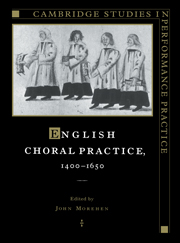Book contents
- Frontmatter
- Contents
- List of plates
- General preface
- Preface
- Abbreviations
- 1 To chorus from quartet: the performing resource for English church polyphony, c. 1390–1559
- 2 Editing and performing musica speculativa
- 3 The sound of Latin in England before and after the Reformation
- 4 English pronunciation, c. 1500 – c. 1625
- 5 Byrd, Tallis and Ferrabosco
- 6 John Baldwin and changing concepts of text underlay
- 7 Sacred songs in the chamber
- 8 The education of choristers in England during the sixteenth century
- 9 The ‘burden of proof’: the editor as detective
- Index of names and places
- Index of manuscript and printed music sources
- Index of works cited
4 - English pronunciation, c. 1500 – c. 1625
Published online by Cambridge University Press: 03 March 2010
- Frontmatter
- Contents
- List of plates
- General preface
- Preface
- Abbreviations
- 1 To chorus from quartet: the performing resource for English church polyphony, c. 1390–1559
- 2 Editing and performing musica speculativa
- 3 The sound of Latin in England before and after the Reformation
- 4 English pronunciation, c. 1500 – c. 1625
- 5 Byrd, Tallis and Ferrabosco
- 6 John Baldwin and changing concepts of text underlay
- 7 Sacred songs in the chamber
- 8 The education of choristers in England during the sixteenth century
- 9 The ‘burden of proof’: the editor as detective
- Index of names and places
- Index of manuscript and printed music sources
- Index of works cited
Summary
The purpose of this chapter is to consider how the texts of church anthems and other English-texted music might have been pronounced in the sixteenth and seventeenth centuries. The practical process of reconstructing pronunciation for performance purposes, illustrated later for texts set c. 1505, c. 1580 and c. 1622, relies upon a range of assumptions, some more contentious than others. Formal study in the field of the history of the English language can inform us only so far, for reasons which will be outlined below.
Leaf through any anthology of Tudor anthems and one is left in no doubt that music in the late sixteenth and early seventeenth centuries was set to an English very little different from today's. Although spellings were rather erratic, there is almost no difficulty in understanding the words or grammatical structures. Like Shakespeare's works, the texts of both sacred and secular music during the Elizabethan and Jacobean periods were in modern English, albeit a form technically known as Early Modern English. However, the similarity in appearance belies differences in pronunciation. A closer look will in fact uncover discrepancies, even to the untrained eye, though we are, as readers both of song-texts and of poetry in its own right, remarkably adept at overlooking and, indeed, misinterpreting the signs. We take for granted, for example, ‘eye-rhyme’, placing into that category many pairings which were originally true rhymes. If we were more accustomed to expecting true rhymes in works of this period then we might more readily attribute the failure of rhyme to subsequent changes in the language rather than to any deliberate choice on the part of the poet.
- Type
- Chapter
- Information
- English Choral Practice, 1400–1650 , pp. 90 - 108Publisher: Cambridge University PressPrint publication year: 1996



